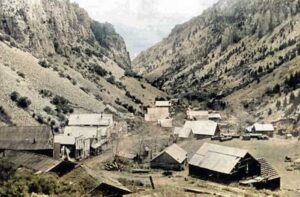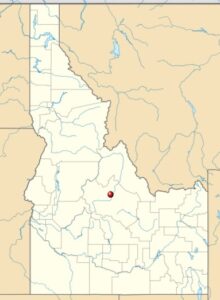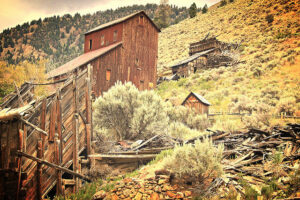 Sometimes, towns get their names in unusual ways. That is exactly how the town, now ghost town of Bayhorse, Idaho got its name. In the Yankee Mining District, about 40 miles east of what would later become the boom towns of Bonanza and Custer City. Bayhorse was founded, a bit unconventionally in 1864, when a few small gold veins were found, and a small camp began. That all seems normal for gold strikes, but from that came an unusual tale of how the settlement came by its name. The most popular story is that area prospectors met a miner digging between Clayton and Challis with the help of two bay horses. That doesn’t seem unusual either, but when asked who the miner was, they couldn’t remember the name, so they said, “The man with the bay horses.” The name stuck.
Sometimes, towns get their names in unusual ways. That is exactly how the town, now ghost town of Bayhorse, Idaho got its name. In the Yankee Mining District, about 40 miles east of what would later become the boom towns of Bonanza and Custer City. Bayhorse was founded, a bit unconventionally in 1864, when a few small gold veins were found, and a small camp began. That all seems normal for gold strikes, but from that came an unusual tale of how the settlement came by its name. The most popular story is that area prospectors met a miner digging between Clayton and Challis with the help of two bay horses. That doesn’t seem unusual either, but when asked who the miner was, they couldn’t remember the name, so they said, “The man with the bay horses.” The name stuck.
The actual date of the founding of Bayhorse is recorded as 1877, although active development of the town did  not begin until 1880. While Bayhorse stared out as a gold mining town, the gold was really not the mainstay of the town. Though prospectors continued to comb the area for the next several years, sometimes finding small amounts of gold, it wasn’t until 1872 that the Bayhorse area began to attract numerous miners. Then, three men by the names of WA Norton, Robert Beardsley, and JB Hood discovered a rich vein of silver, and the focus of the town shifted.
not begin until 1880. While Bayhorse stared out as a gold mining town, the gold was really not the mainstay of the town. Though prospectors continued to comb the area for the next several years, sometimes finding small amounts of gold, it wasn’t until 1872 that the Bayhorse area began to attract numerous miners. Then, three men by the names of WA Norton, Robert Beardsley, and JB Hood discovered a rich vein of silver, and the focus of the town shifted.
In 1882, the town increased its smelting capabilities, and soon began producing $300,000 worth of silver over the course of the year. That figures out to $9,240,441.18, in 2024. The town had grown to 300 residents by 1885, and the town had a mill, three stores, a hotel, a restaurant, a meat market, a lodging house, and five saloons. I always find the number of saloons to be rather comical, though common. That same year, the town built a refinery, which allowed the mining industry to issue silver bars. By 1900, the town had extracted over  $10 million in total ores, including silver, lead, and copper. That amounts to $308,014,705.88 today.
$10 million in total ores, including silver, lead, and copper. That amounts to $308,014,705.88 today.
In 1976, the entire community was added to the National Register of Historic Places, making it officially a ghost town. In 2006, the town property was purchased by the state of Idaho and opened to the public in 2009 as part of the Land of the Yankee Fork State Park. The ghost town has several preserved ruins of houses and mining equipment that are still visible on the main dirt street. There are also charcoal kilns that are still intact, that were used to make charcoal to smelt the ore from the mines. In all, it’s an interesting little old ghost town.


Leave a Reply